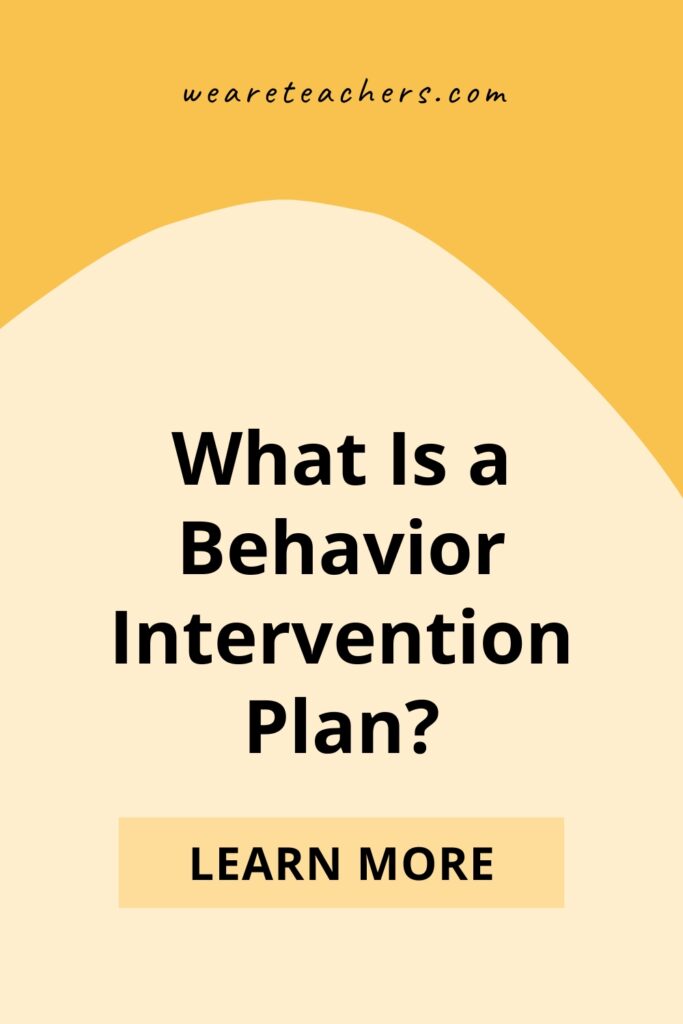For kids who have challenging behaviors, a behavior intervention plan (BIP) can make all the difference. Or it can be just one more piece of paper to keep up with when not used effectively. Here’s our guide to BIPs and what you need to do to make them work for your students (and you).
What is a behavior intervention plan?
When a child’s behavior makes it hard for them and their peers to learn, it’s time for behavior intervention. A BIP is part of behavior intervention, either in MTSS Tier 2 or 3 or as part of a child’s IEP.
The goal of a BIP is to understand a child’s behaviors and teach them replacement behaviors that serve the same function (escape, attention, tactile, or sensory) but that are not disruptive.
A BIP will also include a way to track data so that the team knows if it is working or not.
What goes into a behavior intervention plan?
A BIP includes:
- Strategies that focus on the function of the behavior
- Proactive strategies and techniques to prevent behaviors
- Reactive strategies and techniques to manage behaviors when they occur
- Specific rewards that will motivate the child (stickers, prizes, privileges)
For example, if a child has trouble during transitions and they refuse to transition from one activity to another, the BIP may include:
- A visual schedule to help with transitions (proactive)
- Limited choice during transitions to reduce negative behaviors (reactive)
- A chart for positive reinforcement to provide reinforcement at school (rewards)
A behavior intervention plan is not …
A BIP is not a behavior tracker. A form that tracks a student’s behavior and collects stickers or smiley faces is great for data collection or rewards, but it’s not actually a BIP.
A BIP is also not a silver bullet. Having a BIP does not automatically solve problem behaviors. It’s all in the implementation.
Does a child have to have an IEP to have a BIP?
No. Any child that has problem behaviors and has a functional behavior plan (FBA) can have a BIP. Any child can receive a BIP, and any teacher, counselor, or parent can request a BIP.
Students with IEPs may have a BIP because their disability is such that they need to focus on learning positive behaviors to succeed in school. Or they demonstrate behaviors that impact their learning and require a BIP to address them. In particular, students with disabilities who have been suspended for more than 10 days or who are attending outside placements must have a BIP under federal law.
A student’s BIP is often a topic in a manifestation determination meeting. Read more about those here: What Is a Manifestation Determination Meeting?
How many behaviors can a BIP focus on?
As few as possible, but no more than four or five at a time.
A BIP could also focus on a specific time during the day. If a student has more behaviors during math class, for example, a BIP might focus on addressing behaviors in that environment before addressing other areas of the school day.
What goals are in a behavior intervention plan?

Source: Pexels.com
Behavior goals are, like many other IEP goals, SMART:
- Specific
- Measurable
- Attainable
- Realistic
- Time-bound
Another way of thinking about goals is to write them using this template:
- By …
- Who (student) …
- Will do what …
- Under what conditions …
- At what proficiency level …
- With what measurement …
So, a goal could be: By February, Julia will raise her hand to ask a question or make a comment during whole-class discussion with 90% accuracy in 4/5 opportunities in 1 month as measured by a teacher checklist.
The goal should be based off of what behaviors the student was demonstrating during the FBA. So, if work completion was a target behavior, and during the FBA, the student finished work 10% of the time, their goal should be realistic. A 100% target isn’t realistic. But improving to 25% within 3 months and 50% work completion after 5 months is more reasonable.
A goal could also focus on how much support a child needs to demonstrate the behavior. If a child requires prompting every 20 seconds during independent work, a goal could be to reduce the level of prompting to every 30 seconds and then every 45 seconds.
Who implements the behavior intervention plan?
The answer: everyone. If a child does not have an IEP, the BIP will be implemented by the team of teachers and likely monitored by a behavior interventionist. If the child has an IEP, then the special education teacher may implement and monitor it, but if the child is in your class and they have a BIP, you are in charge of implementing those strategies.
How do we know a behavior intervention plan is working?
When a child has a BIP, data is collected and the team reviews the data regularly. Data can be collected on a checklist, chart, or report card.
If the BIP isn’t working, the data will show it, and you probably won’t need a chart to tell you.
Ways To Track BIP Progress
- A checklist can help track how often a child is on task, or how long they are engaged in an activity or following directions.
- Charts are helpful for monitoring how often a child demonstrates a goal behavior (waiting their turn, using a communication system instead of hitting).
- Daily report cards can track how a student is demonstrating positive behaviors from class to class.
How the progress of a BIP is tracked will be determined, in part, by how old the child is. A kindergartner who is in the same room all day could use a behavior chart, while a middle schooler who goes from class to class might benefit more from a daily report card.
What if the BIP doesn’t work?
If the data and teacher and parent input clearly show the BIP isn’t working, it’s time to reevaluate it. The function of the behavior may be wrong, the strategies may not be the appropriate ones, or the situation may have changed. Kids grow and change, and they may simply have outgrown their BIP. Whatever the reason, the team will want to come back to the drawing board and rework the BIP, then track data again until there is progress.
For example, an FBA may identify that a child’s aggressive behaviors serve the function of getting attention from their teacher. So the team puts a communication board in place to help the child communicate when they want attention, but the behavior also served a “tangible” function because the child wants a toy. The team might have to add in a replacement behavior to address the additional function before the BIP will work.
What if the BIP works?
If a child achieves their BIP goals, first, the child should be feeling successful. A typical goal is to achieve desired behavior 80% to 90% of the time.
Once a behavior doesn’t impact the child’s learning, the team can focus on another behavior, in which case it might be back to another FBA. Or the child may not need a BIP anymore. In which case, success!
Additional Resources
Here is a helpful printable for parents from the PACER Center.
The Center on Positive Behavioral Interventions & Supports has resources on FBAs and BIPs.
Basic FBA to BIP has resources for completing FBAs.
The Iris Center at Vanderbilt University has a module on FBAs and BIPs.
Do you have additional questions about using a behavior intervention plan? Connect with other teachers in the WeAreTeachers HELPLINE on Facebook.
For more practical articles for teachers, be sure to subscribe to our newsletters.


